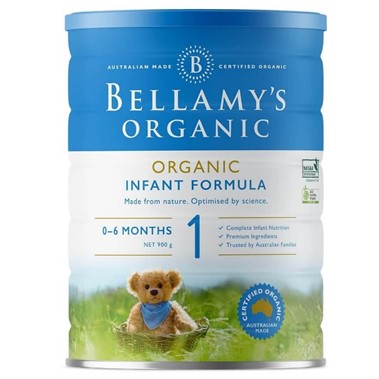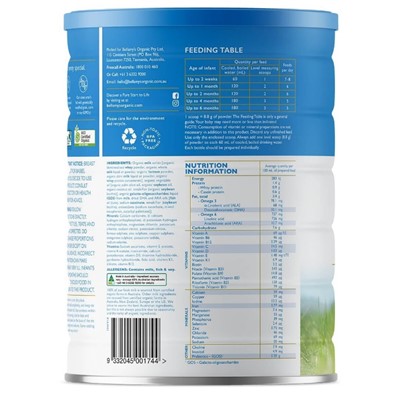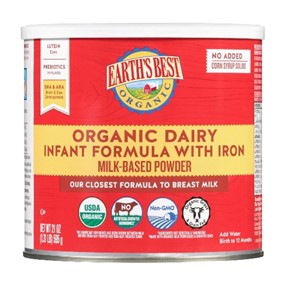As a new mom and a doctor, I understand the importance of providing my baby with the best possible nutrition. While breast milk is the optimal source of nutrition for infants, sometimes, circumstances prevent breastfeeding. That’s why I decided to try Earth’s Best Organic Dairy Infant Formula, and in this review, I will share my experience using it, its advantages and disadvantages, pricing, professional recommendations, and usage key points.

Advantages:
One of the major advantages of Earth’s Best Organic Dairy Infant Formula is that it is made from organic ingredients, meaning it is free from harmful pesticides, herbicides, and genetically modified organisms. As a pediatrician, I recommend organic products as they provide a safer and more nutritious option for infants.
Another advantage of this formula is its balanced nutrition. It contains essential nutrients such as carbohydrates, proteins, fats, vitamins, and minerals that are vital for infant growth and development. Additionally, it contains prebiotics that support the development of a healthy gut microbiome and support the immune system.
The formula is also easy to prepare, and it dissolves quickly without clumping, making it a convenient option for busy parents.

Disadvantages:
One of the disadvantages of Earth’s Best Organic Dairy Infant Formula is its taste. Some babies may find the taste slightly different from breast milk or other formula brands, which may make it difficult for them to adjust to it.
Another disadvantage is the cost. It is more expensive than other non-organic formula options available in the market. However, the benefits of using organic and more nutritious ingredients justify its cost.
Price:
Earth’s Best Organic Dairy Infant Formula is more expensive than non-organic formula options. A 23.2 oz container costs around $28, while a 35 oz container costs around $44. While it may be more expensive, it is worth the cost considering the benefits it provides.

Professional Tips:
Follow the instructions on the formula package carefully, including how much water and powder to use.
It’s important to follow the instructions on the formula package exactly, as the ratio of water to powder can affect the nutrition and digestibility of the formula. Using too little water can make the formula too concentrated and difficult for your baby to digest, while using too much water can dilute the formula and not provide enough nutrition. Always use the scoop provided with the formula and level it off with a clean knife or spatula to ensure accurate measurements.
Wash your hands thoroughly before handling formula and bottles.
Before preparing formula or feeding your baby, wash your hands thoroughly with soap and water. This helps prevent the spread of germs and reduces the risk of infection.
Sterilize bottles and nipples before using them for the first time, and after that, wash them with hot, soapy water and rinse thoroughly.
New bottles and nipples should be sterilized before the first use to remove any bacteria or germs that may be present. After that, wash the bottles and nipples with hot, soapy water and rinse thoroughly to remove any formula residue. Some parents choose to use a dishwasher to clean their baby’s bottles, but be sure to follow the manufacturer’s instructions and use a dishwasher-safe bottle and nipple.
Use boiled water or bottled water that has been sterilized for mixing formula.
The water you use to mix formula should be clean and free of contaminants. Boiling water for one minute is one way to sterilize it, but if you use bottled water, be sure to check that it is labeled as sterilized for infant consumption.
Use a clean measuring cup to measure the formula powder, and level off the powder with a clean knife or spatula.
When measuring formula powder, always use a clean measuring cup and level off the powder with a clean knife or spatula. This ensures accurate measurements and prevents overfeeding.
Test the temperature of the formula on the inside of your wrist before feeding it to your baby. It should feel warm, but not hot.
To test the temperature of the formula, drip a few drops on the inside of your wrist. It should feel warm, but not hot. If the formula is too hot, let it cool down before feeding your baby.
Discard any leftover formula that has not been consumed within one hour of preparation.
Formula that has been sitting out for more than one hour should be discarded, as bacteria can grow in it and make your baby sick.
Pay attention to your baby’s hunger cues and feed on demand.
Babies have different feeding needs and may require more or less formula than the recommended amount. Pay attention to your baby’s hunger cues, such as rooting or sucking on their hands, and offer them the bottle when they show signs of hunger.
Contact your healthcare provider if you have any questions or concerns about feeding formula to your baby.
Key Points for Usage:
To ensure the safe and proper use of Earth’s Best Organic Dairy Infant Formula, it is important to follow the instructions on the packaging carefully. The formula should be mixed with water and shaken well before feeding. It is also essential to use clean bottles and nipples to prevent contamination.
Conclusion:
In conclusion, Earth’s Best Organic Dairy Infant Formula is a highly recommended formula for parents who want to provide their babies with a safe and nutritious alternative to breast milk. Its organic ingredients, balanced nutrition, and prebiotics make it a healthy option for infant growth and development. While it may be more expensive than non-organic formula options, its benefits justify its cost. Additionally, its convenience and ease of preparation make it a convenient option for busy parents.
